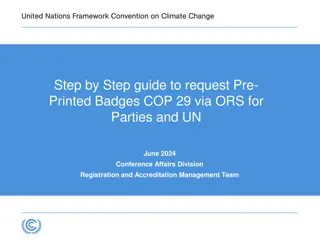Enhancing Family Engagement in Educational Communities
Explore strategies for engaging all families in educational settings to support student outcomes. Understand the difference between family involvement and family engagement, and discover examples in practice. Learn how active family engagement can benefit students, families, schools, and communities.
Download Presentation

Please find below an Image/Link to download the presentation.
The content on the website is provided AS IS for your information and personal use only. It may not be sold, licensed, or shared on other websites without obtaining consent from the author.If you encounter any issues during the download, it is possible that the publisher has removed the file from their server.
You are allowed to download the files provided on this website for personal or commercial use, subject to the condition that they are used lawfully. All files are the property of their respective owners.
The content on the website is provided AS IS for your information and personal use only. It may not be sold, licensed, or shared on other websites without obtaining consent from the author.
E N D
Presentation Transcript
Strategies for Engaging All Families in Your Work Family Engagement Communities of Practice November 19, 2019
Learning Outcomes Increase understanding of the importance of family engagement in supporting social and academic outcomes for students and their families. Understand the importance of engaging all members of the community, particularly fathers and other male role models. Introduce the "WATCH D.O.G.S." (Dads of Great Students), one program being implemented in a Virginia division.
Family Engagement in VTSS ...an active, interactive, dynamic, and ongoing process in which family members and key stakeholders engage as equal partners in decision- making, planning, and implementation to support children and adolescents across settings . Aligning and Integrating Family Engagement in PBIS
Involvement and Engagement (Ferlazzo, 2011) One dictionary definition of involve is "to enfold or envelope," whereas one of the meanings of engage is "to come together and interlock." Involvement implies doing to; in contrast, engagement implies doing with.
Is it Family Involvement or Engagement? Please respond to four scenarios. Do you think each scenario is an example of family engagement or family involvement?
Scenarios 1. Holding a fall back-to-school open house where parents/caregivers follow their student's daily schedule and hear about each teacher's expectations and grading policies 2. Asking a grandfather of a student in the school to mow the back baseball field weekly. 3. Recruiting a mother of a student to participate regularly on the schoolwide PBIS team; when she cannot attend, she Skypes in. 4. Inviting 3 dads and moms to serve on a math textbook selection committee; their votes are considered equally with other committee members.
Involvement and Engagement It's not that family involvement is bad. Almost all the research says that any kind of increased parent interest and support of students can help. But almost all the research also says that family engagement can produce even better results for students, for families, for schools, and for their communities (Ferlazzo & Hammond, 2009). Family involvement and engagement are not mutually exclusive; most schools pursue both.
Chat Box Share Out What family engagement barriers or concerns have you experienced within your role?
Formed Families Forward Beth Spivack Family Support and Outreach Director https://formedfamiliesforward.org/
Strengthening Family Engagement to Improve Outcomes for Children Fathers play an important role in their children s development and well-being, from birth through adulthood. Having an involved father increases the likelihood that children will experience positive education, health, self-esteem, and social outcomes. Compared to children raised in two-parent homes, children raised in father-absent homes are at greater risk of poverty, teen pregnancy, drug and alcohol abuse, behavioral problems, child abuse and neglect, and dropping out of high school. McClay, A. & Karberg, E. (2019)
Challenges Compared to mothers, fathers are less likely to live with their children. This varies by demographics. We know: 26% of fathers do not live with their children. More white fathers (80%) live with their children than black (49%) and Hispanic (62%) fathers. Men who become fathers at older ages are more likely to report living with all of their minor children.
Challenges, 2 As a father s educational attainment increases, the share of fathers living with all of their minor children also rises. As a result, our students may be less likely to see fathers and other strong males on a regular basis.
Fathers Contributions Fathers are more likely to use advanced language around young kids, which promotes vocabulary development. Fathers also tend to prioritize rough-and-tumble play, letting kids explore, and playing more than caretaking, which establish independence and positive social skills. Positive father engagement has been linked to better outcomes on measures of child well-being, such as cognitive development, educational achievement, self-esteem, and pro-social behavior. Scott, M.E & Karberg, E. (2016)
Community-based Programs Directly serve fathers themselves and incorporate lessons on parenting, co-parenting, and healthy relationships. Help with professional skill-building and job searching, and have been shown to improve fathers employment rates. The federal government funded nearly 50 organizations across the United States to provide these types of Responsible Fatherhood activities. Scott, M.E. & Karberg, E. (2016)
Watch D.O.G.S. Program (Dads of Great Students) Sean Slaney, ESOL Teacher and Family Engagement Coordinator at Baldwin Elementary, Manassas City Public Schools Baldwin Elementary School
Why it matters: Positive Male Role Models More successful in school! Better chance of Elementary and post secondary school success! Enhanced school safety and security Extra set of eyes, help during recess, building patrols
What WATCH D.O.G.S. Do In the classroom: Read to students Games Small groups Talk to students In the cafeteria: Help with lunches Talk to students Give high fives Make sure students are being safe In the Hallway: Say hello to students Give high fives Make sure students are being safe (no running)
Baldwin Elementary Schools Watch D.O.G.S. History Watch D.O.G.S. started at Baldwin 3 years ago. That year we transitioned to a new school building. We waited to kick off the program until we made the move to the new building and came back from winter break.
Baldwin Elementary Schools Watch D.O.G.S. Kickoff For our kickoff event we use two cafeterias and our school s gym. We have pizza in one cafeteria and the presentation in the other. During the presentation students go to the gym.
Baldwin Elementary Schools Watch D.O.G.S. History Outcomes Since we began Watch D.O.G.S. we ve had eighty-nine Watch D.O.G.S. sign up. Our Pizza Nights were attended by hundreds of and students and their families.
Questions for Sean? https://dadsofgreatstudents.com/index.php/default/ Contact Information: Email: sslaney@mcpsva.org Twitter: @SeanSlaney1
Upcoming Virtual Communities of Practice February 4, 2020 The Value of Family Engagement Data April 14, 2020 Family Engagement and the Administrators' Role
Team Discussion Questions What questions do you have about the role of data in supporting family engagement? What would you like to learn, or share, about how administrators can, or are, supporting family engagement in your division? Are there any resources or questions you have for your VTSS Systems Coach?
Please respond in the chat box! Please share a specific step to help your team move forward or information you will share you after today s webinar.























